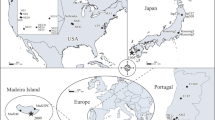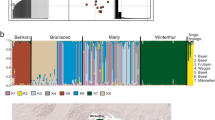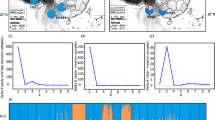Abstract
This paper summarizes the results of our study of the pinewood nematode (Bursaphelenchus xylophilus). By population genetic analysis, it was determined that there was no genetic bottle caused by the founder effect and genetic drift in the Chinese invasive population. Multiple invasions with large amounts of nematodes from different sources led to rich genetic diversity in the invasive population. Keeping high genetic diversity in the invasive process may be one of the genetic mechanisms in its successful invasion. By testing interspecies competition, it was shown that, with high fecundity and a strong competitive ability, B. xylophilus outcompeted the native species B. mucronatus in the natural ecosystem during the invasion process. Competitive displacement may be one of the ecological mechanisms of B. xylophilus’s invasion. In addition, an unequal interspecific hybridization with introgress was in favor of the invasive species which also accelerated the replacement of B. mucronatus by B. xylophilus. The structures, functions and evolutions of a few important genes that are closely related to the ecological adaptation of pinewood nematodes were studied to explore the molecular mechanism of its ecological adaptations. Further, the resistance and resilience mechanism of the pine ecosystem invaded by pinewood nematodes was also investigated. The results of these studies uncovered a portion of the genetic and ecological mechanisms of PWN’s successful invasion and laid a foundation for further study to obtain a comprehensive interpretation of the mechanisms of the nematode invasion. The results also provided a scientific basis for effectively controlling the occurrence and spread of pine wilt disease which is caused by nematodes. Various aspects requiring further investigation are considered.
Similar content being viewed by others
References
Xie B Y, Cheng X Y, Lu Q, et al. Pinewood nematode. In: Wang F H, Zheng X B, Guo J Y, eds. Biology and Management of invasive Alien Species in Agriculture and Forestry (In Chinese). Beijing: Science Press, 2005. 573–616
Yang B J, Tang J, Wang Y Y, et al. Pine Wilt Disease (In Chinese). Beijing: Chinese Forest Publishing House, 2003
Cheng X Y, Xu R M. Rapid evolution and bioinvasion. In: Xu R M, Ye W H, eds. Bioinvasion — theory and practice (In Chinese). Beijing: Science Press, 2003. 102–118
Cheng F X, Cheng X Y, Xie B Y, et al. Use of the amplified fragment length polymorphism technique for genetic diversity analysis of the pinewood nematode (Bursaphelenchus xylophilus) (In Chinese). Acta Phytopathol Sin, 2005, 35: 410–419
Cheng X Y, Cheng F X, Xu R M, et al. Genetic variation in invasive process of Bursaphelenchus xylophilus (Aphelenchida: Aphelenchoididae) and its possible spread routes in China. Heredity, 2008, 100(4): 356–365, 18091770, 10.1038/sj.hdy.6801082, 1:CAS:528:DC%2BD1cXjslSqsL4%3D
Gurevitch J, Padilla D K. Are invasive species a major cause of extinctions? Trends Ecol Evol, 2004, 19: 470–474, 16701309, 10.1016/j.tree.2004.07.005
Bøhn T, Amundsen P A, Sparrow A. Competitive exclusion after invasion? Biol Invasions, 2007, 359–368
Cheng X Y, Xie P Z, Cheng F X, et al. Competitive displacement of the native species Bursaphelenchus mucronatus by an alien species Bursaphelenchus xylophilus (Nematoda: Aphelenchida: Aphelenchoididae)-a case of successful invasion. Biol Invasions, 2008, 11:205–213, 10.1007/s10530-008-9225-2
Rutherford T A, Riga E, Webster J M. Temperature-mediated behavioral relationships in Bursaphelenchus xylophilus, B. mucronatus and their hybrids. J Nematol, 1992, 24: 40–44, 19283200, 1:STN:280:DC%2BD1M3gsFCnug%3D%3D
Jikumaru S, Togashi K. Boarding abilities of Bursaphelenchus mucromus and B. xylophilus (Nematoda: Aphelenchoididae) on Monochamus alternatus (Coleoptera: Cerambycidae). Nematology, 2003, 5: 843–849, 10.1163/156854103773040745
Vincent B, Altemayer V, Roux-Morabito G, et al. Competitive interaction between Bursaphelenchus xylophilus and the closely related species Bursaphelenchus mucronatus. Nematology, 2008, 10: 219–230, 10.1163/156854108783476403
Garcia-Serrano H, Sans F X, Escarre J. Interspecific competition between alien and native congeneric species. Acta Oecol, 2007, 31:69–78, 10.1016/j.actao.2006.09.005
Rhymer J M, Simberloff D. Extinction by hybridization and introgression. Ann Rev Ecol Syst, 1996, 27: 83–103, 10.1146/annurev.ecolsys.27.1.83
Mooney H A, Cleland E E. The evolutionary impact of invasive species. Proc Natl Acad Sci USA, 2001, 98(10): 5446–5451, 11344292, 10.1073/pnas.091093398, 1:CAS:528:DC%2BD3MXjs1Wgurw%3D
Ellstrand N C, Schierenbeck K A. Hybridization as a stimulus for the evolution of invasiveness in plants? Proc Natl Acad Sci USA, 2000, 97(13): 7043–7050, 10860969, 10.1073/pnas.97.13.7043, 1:CAS:528:DC%2BD3cXksVKisbk%3D
Mamiya Y. Interspecific hybridization between Bursaphelenchus xylophilus and B. mucronatus (Aphelenchida: Aphelenchoididae). Applied Ent Zool, 1986, 21: 159–163
Riga E, Webster J M. Viability and behaviour of inter- and intraspecific crosses of pinewood nematode isolates. J Nematol, 1989, 21:582
Liu W, Yang B J. Hybridization between Bursaphelenchus xylophilus and B. mucronatus(In Chnese). Forest Res, 1994, 7: 469–474
Dai S M, Cheng X Y, Xiao Q M, et al. Research progress in nematode cold tolerance (In Chinese). Acta Ecol Sin, 2006, 26: 3885–3890, 1:CAS:528:DC%2BD2sXisVWhsQ%3D%3D
Sorensen J G, Kristensen T N, Loechche V. The evolutionary and ecological role of heat shock proteins. Ecol Lett, 2003, 6:1025–1037, 10.1046/j.1461-0248.2003.00528.x
Dai S M, Cheng X Y, Xiao Q M, et al. Cloning and prokaryotic expression of Hsp70 from pine wood nematode (Bursaphelenchus xylophilus) (In Chinese). Acta Phytopathol Sin, 2007, 37: 512–519
Takemoto S, Futai K. Polymorphism of Japanese isolates of the pinewood nematode, Bursaphelenchus xylophilus (Aphelenchida: Aphelenchoididae), at heat-shock protein 70A locus and the field detection of polymorphic populations. Appl Entomol Zool, 2007, 42(2): 247–253, 10.1303/aez.2007.247, 1:CAS:528:DC%2BD2sXnsVSnt7s%3D
Kikuchi T, Jones J T, Aikawa T, et al. A family of glycosyl hydrolase family 45 cellulases from the pine wood nematode Bursaphelenchus xylophilus. FEBS Lett, 2004, 572: 201–205, 15304348, 10.1016/j.febslet.2004.07.039, 1:CAS:528:DC%2BD2cXmsVGhtr0%3D
Smant G, Stokkermans J P, Yan Y, et al. Endogenous cellulases in animals: Isolation of β-1,4-endoglucanase genes from two species of plant-parasitic cyst nematodes. Proc Natl Acad Sci USA, 1998, 95:4906–4911, 9560201, 10.1073/pnas.95.9.4906, 1:CAS:528:DyaK1cXivVyqu70%3D
Rosso M N, Piotte C, Favery Y B, et al. Isolation of a cDNA encoding a β-1,4-endoglucanase in the root-knot nematode Meloidogyne incognita during plant parasitism. Mol Plant Microbe Interact, 1999, 12:585–591, 10478479, 10.1094/MPMI.1999.12.7.585, 1:CAS:528:DyaK1MXktVChtLo%3D
Zhang Q, Bai G, Yang W, et al. Pathogenic cellulose assay of pine wilt disease and immunological localization. Biosci Biotechnol Biochem, 2006, 70: 2727–2732, 17090937, 10.1271/bbb.60330, 1:CAS:528:DC%2BD28XhtlSit7rF
Henkle-Dührsen K, Kampkötter A. Antioxidant enzyme families in parasitic nematodes. Mol Biochem Parasit, 2001, 114(2): 129–142, 10.1016/S0166-6851(01)00252-3
An S J, Zhang X L, Wang Z, et al. Remote sensing technology in estimating biomass (In Chinese). Forest Inventory Plan, 2006, 31:1–5
Wang L, Zhang X, Luo Y, et al. A study on the changes of Pinus Massoniana spatial pattern by pinewood nematode invasion based on remote sensing and GIS. IGARSS, 27th edn. Colorado: Denver, 2006. 2697–2700
Wang L, Zhang X, Luo Y Q, et al. A study on the changes of Pinus Massoniana spatial pattern by pinewood nematode invasion based on remote sensing and GIS (In Chinese). IGARSS, 27th ed. Colorado: Denver, 2006
Shi J, Luo Y Q, Song J Y, et al. Effects of different removal disturbance intensity on plant diversity of Bursaphelenchus xylophilusinvaded Masson pine community (In Chinese). J Chinese Appl Ecol, 2006, 17: 1157–1163
Shi J, Luo Y Q, Wu H W, et al. Impact of Bursaphelenchus xylophilus’s invasion on the function of plant community in Masson pine forests (In Chinese). Beijing Forest Uni, 2007, 29: 118–124
Shi J, Luo Y Q, Zeng F Y, et al. Impact of invasion of pine wood nematode on the niche of main populations in Masson pine community (In Chinese). J Beijing Forest Univ, 2005, 27: 76–82
Shi J, Luo Y Q Yan X S, et al. Analysis on response of pine forest to disturbance of pine wood nematode with interpretative structural model. Scientia Silvae Sinicae, 2007, 43: 85–90 [In Chinese]
Song J Y, Luo Y Q, Shi J, et al. Niche characteristics of boring insects within Pinus massoniana infected by Bursaphelenchus xylophilus (In Chinese). J Beijing Forest Univ, 2005, 27:108–111, 1:CAS:528:DC%2BD28XksFOmu7Y%3D
Song J Y, Luo Y Q, Shi J, et al. Niche of insect borers within Pinus massoniana infected by pine wood nematode. Front Forest China, 2006(4): 460–463
Song J Y, Luo Y Q, Shi J, et al. Niche of insect borers within Pinus massoniana infected by pine wood nematode (In Chinese). Front Forest China, 2006: 460–463
Zhao L L, Wei W, Kang L, et al. Chemotaxis of the pinewood nematode, Bursaphelenchus xylophilus, to volatiles associated with host pine, Pinus massoniana, and its vector Monochamus alternatus. J Chem Ecol, 2007, 33(6): 1573–1561, 10.1007/s10886-007-9289-y, 1:CAS:528:DC%2BD2sXlslOgtr8%3D
Zhao L L, Wei W, Kang L, et al. Chemotaxis of the pinewood nematode, Bursaphelenchus xylophilus, to volatiles associated with host pine, Pinus massoniana, and its vector Monochamus alternatus (In Chinese). J Chem Ecology, 2007, 33: 1573–1561, 10.1007/s10886-007-9289-y, 1:CAS:528:DC%2BD2sXlslOgtr8%3D
Yang B J. Advance in research of pathogenetic mechanism of pine wood nematode. Forest and Disease, 2002, 21: 27–31 [In Chinese], 1:CAS:528:DC%2BD38Xis12quro%3D
Tan J J, Ye J R. Research advance in pathogenic mechanism of pine wood nematode disease (In Chinese). J Huazhong Agricult Univ, 2003, 22: 613–617, 1:CAS:528:DC%2BD2MXovVantA%3D%3D
Author information
Authors and Affiliations
Corresponding author
Additional information
Supported by the National Key Basic Research and Development Program of China (Grant Nos. 2009CB119200 and 2002CB111400).
Rights and permissions
About this article
Cite this article
Xie, B., Cheng, X., Shi, J. et al. Mechanisms of invasive population establishment and spread of pinewood nematodes in China. SCI CHINA SER C 52, 587–594 (2009). https://doi.org/10.1007/s11427-009-0071-y
Received:
Accepted:
Published:
Issue Date:
DOI: https://doi.org/10.1007/s11427-009-0071-y




